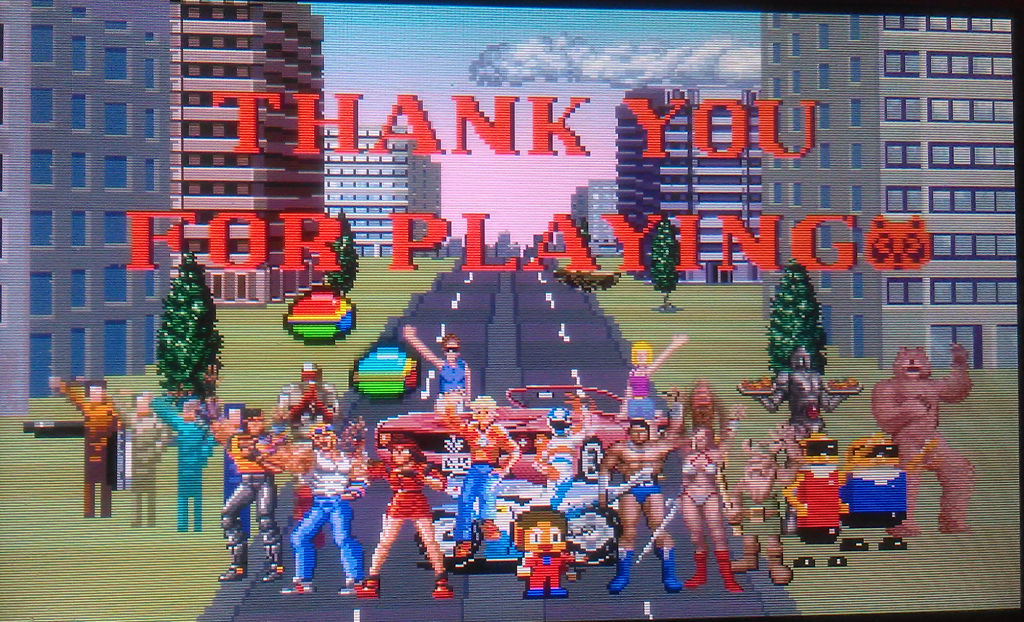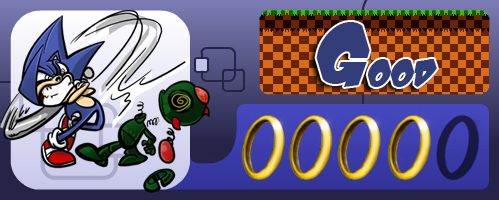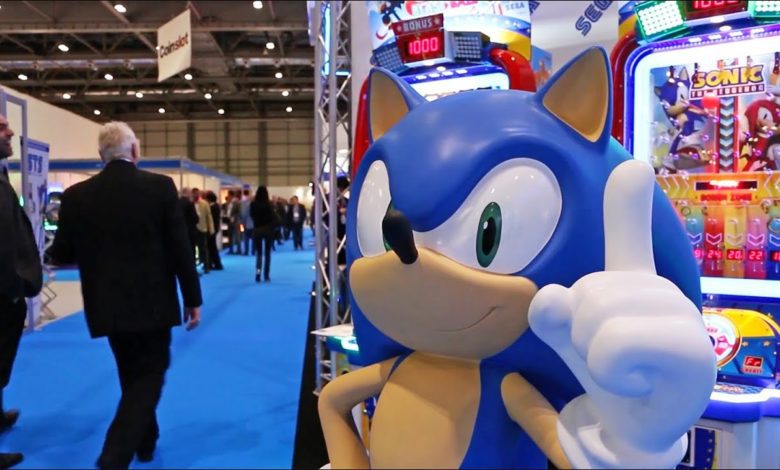
Review: 3D Thunder Blade (3DS)
QUICK LOOK
GOOD
GOOD
3D Thunder Blade holds its own with the other arcade classics and is a damn fine addition to the SEGA 3D Classics library.
When it comes to SEGA’s legendary arcade cabinets, many games come to mind. Hang-On, OutRun, After Burner II and Space Harrier are just a small example SEGA’s legendary arcade craftsmanship that featured a physical experience rather than simply hitting buttons.
At the time, almost every deluxe cabinet was immaculately built with great gameplay and design. One of SEGA’s best years for its arcade business was 1987. As both Super Hang-On and After Burner II were gobbling quarters left and right and gaining fans, there was one other SEGA classic arcade that’s barely mentioned alongside those greats.
Enter Thunder Blade, another “physical experience” arcade by SEGA that came in both a standard, up-right and deluxe cabinet. For years, I’ve known about the most famous SEGA cabinets, but barely heard of Thunder Blade to be honest. I’ve played Super Thunder Blade once or twice on the Genesis, but never got the chance to try the actual arcade game, or cabinet for myself. Thanks to Yosuke Okunari and the team over at M2, I finally have the chance to play the arcade version of Thunder Blade and see if it stacks up to the other SEGA arcade classics.
After Burner in a helicopter
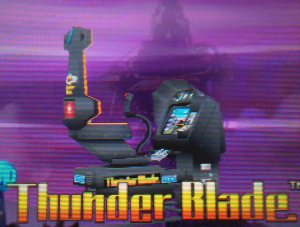 Thunder Blade is essentially After Burner in a helicopter but with a couple twists. In Thunder Blade, you pilot a helicopter and basically destroy everything in your path. It’s pretty much the same concept in a different vehicle, with little to no story involved … just plain ol’ arcade fun.
Thunder Blade is essentially After Burner in a helicopter but with a couple twists. In Thunder Blade, you pilot a helicopter and basically destroy everything in your path. It’s pretty much the same concept in a different vehicle, with little to no story involved … just plain ol’ arcade fun.
Boiled down to its basics, Thunder Blade is a 3-D shoot-em-up mixed with a vertical shooter. You start every stage taking off from a top-down perspective (by pulling up on the control stick) flying for a couple feet to get used to your controls, and then you’re thrown in to a vertical stage, shooting down enemies in the air and on the ground, similar to Xevious or RayForce. You can also change your altitude in these stages, either flying close to the ground or way up in the skies.
After taking down some ground targets, the perspective changes, and suddenly you’re flying a helicopter head on into tanks, other helicopters, F-14 Tomcats and enemy fire, almost like After Burner but with way more things to avoid and a lot more obstacles to crash into.
After completing the stage, you go back to top-down mode to bomb an enemy battleship, 1943 style. These stages are fun too, but there are just way too many things to avoid to survive not losing lives in these sections.
Your helicopter is equipped with your standard military grade weapons, with a machine gun and missile setup. The catch is that you actually have to aim your missiles, none of that After Burner locking on stuff here!
A helluva learning curve
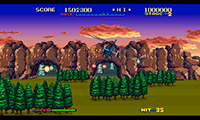 At standard difficulty, a minor scrape off the side of a building is automatic death, so keeping track of your helicopter in relation to the landscape is a must.
At standard difficulty, a minor scrape off the side of a building is automatic death, so keeping track of your helicopter in relation to the landscape is a must.
If you’re a newcomer to Thunder Blade, I suggest setting the difficulty to one star to begin with. Otherwise, you’ll likely end up crashing into everything before you get accustomed to the game. Setting the difficulty to one star prevents you from dying if you crash into buildings, which is a godsend.
The only other gripe with the gameplay itself is that it requires a little too much precision to hit some airborne targets with your machine guns in the behind-the-helicopter view stages. I experienced several cheap deaths where I thought I had hit an enemy and then proceeded to run directly into it, thus killing me.
Dem graphics doe
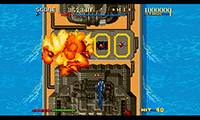 I’ll admit, I wasn’t really expecting much in the graphics department coming into 3D Thunder Blade, but I was floored by the amount of graphical detail on display. The stage and object design is great, with the game looking full 3D at times. The top-down stages look very well put-together; add the fact that most of the sprites are scaling very quickly while changing altitudes, it really is an amazing feat SEGA achieved.
I’ll admit, I wasn’t really expecting much in the graphics department coming into 3D Thunder Blade, but I was floored by the amount of graphical detail on display. The stage and object design is great, with the game looking full 3D at times. The top-down stages look very well put-together; add the fact that most of the sprites are scaling very quickly while changing altitudes, it really is an amazing feat SEGA achieved.
The buildings and structures have a more realistic look the vertical stages compared to the top-down view. But the top-down boss stages are a wonder to look at as well, scaling across the different battleships and such look great on the 3DS’ screen. As a whole, 3D Thunder Blade is a very good-looking game. It runs great as well, is fast paced, with no hint of slowdown whatsoever.
Gimme those M2 extras!
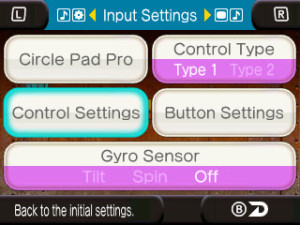 M2 has made quite a name for itself with the 3D Classics, and we all get super giddy to see what extras they include in each new release. Thankfully, there’s plenty in 3D Thunder Blade.
M2 has made quite a name for itself with the 3D Classics, and we all get super giddy to see what extras they include in each new release. Thankfully, there’s plenty in 3D Thunder Blade.
For starters, there are a couple of different cabinet views, with an option to have the cabinet move in conjunction with your controls, just like the actual deluxe cabinet did. This mode offers two backgrounds to choose, one being an arcade with Super Hang-On and After Burner II deluxe cabinets and another that shows a city landscape.
While the backgrounds are nice for what they are, they’re a little too pixelated for my tastes, but the cabinet graphics, on the other hand, look absolutely beautiful. It’s amazing how close M2 got into making them look like the actual cabinet, maybe even a little better in certain aspects.
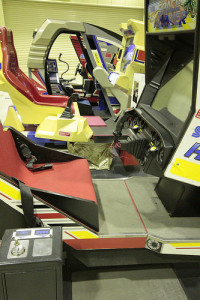 Now, before we get on to what the game’s special mode includes, you should know that the original Thunder Blade kind of abruptly ended after four stages with an incredibly unfulfilling “The End” screen. This meant that seasoned players could breeze through the game pretty quickly, but it also felt a bit underwhelming compared to other games that gave you a more satisfying ending.
Now, before we get on to what the game’s special mode includes, you should know that the original Thunder Blade kind of abruptly ended after four stages with an incredibly unfulfilling “The End” screen. This meant that seasoned players could breeze through the game pretty quickly, but it also felt a bit underwhelming compared to other games that gave you a more satisfying ending.
The extra mode in 3D Thunder Blade fixes this by adding an extra stage after the end boss in stage four, where you fly get to through the enemies’ base, blowing up as much crap as possible. After completing this stage, you get an actual ending, thus fulfilling the dream of many arcade goers from the late ’80s.
Scoring is also different in the special mode compared to arcade mode. In arcade mode, after every stage, you’re graded on how many enemies you hit with your missiles, like the hit counter in After Burner. While you only get bonus points in the arcade mode, you can get extra lives in special mode. Although you still get three continues either way, this added feature makes getting through the game faster and using less continues.
The sound of silence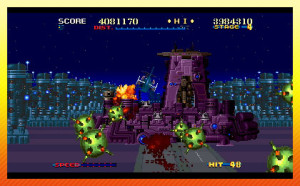
Now, this wouldn’t be a SEGA arcade game if I didn’t talk about the music in some way. Composed by Koichi Namiki (Super Hang-On, Galaxy Force II), Thunder Blade’s soundtrack is pretty damn good.
Just like After Burner, there are two types of soundtracks to choose from, one with extra melodies and one without. Both versions sound good, but I’m partial to the extra versions of the music as they just sound a better. The soundtrack itself is very reminiscent of Galaxy Force, with heavy bass/drums and some smooth, awesome melodies to jam to. Koichi is a great composer who has a style that can’t be emulated.
Summary
Having never played the arcade version of Thunder Blade, I can say that this one can hold its own with the other arcade classics, and is a damn fine addition to the SEGA 3D Classics library. While it’s a very short game, with only four (five in special mode) stages, it’s definitely worth the $5.99 to experience it at least once.
Sadly, it looks like this will be the last arcade title in the 3D Classics series, but I hope that maybe down the road, we’ll get a couple more arcade exclusives, like Power Drift and Turbo OutRun. It’s been a good run, SEGA 3D Classics, may our arcade paths cross again.
PROS
- A perfect arcade conversion of Thunder Blade, with a couple extras thrown in
- Emulated arcade cabinets bring the official arcade experience to your 3DS
- Special Mode actually has an ending!
CONS
- Having more or unlimited credits would have been nice
- Thunder Blade is a little short, being only four stages, some extra stages would have been nice for Special mode
- It is way too easy to die at times



